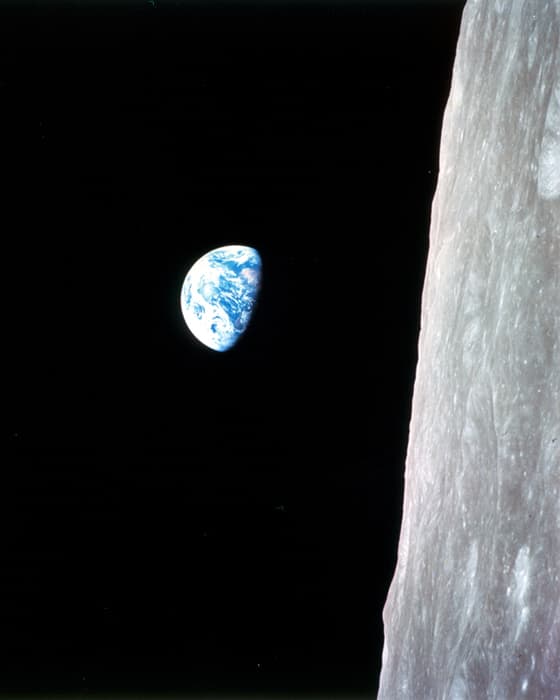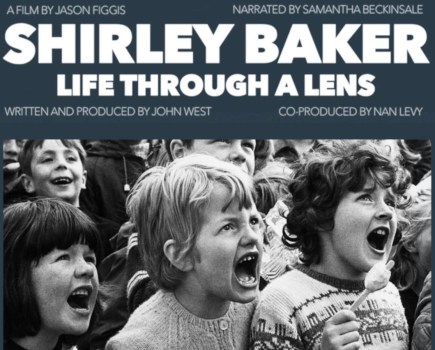Image: The famous ‘Earthrise’ view that greeted the Apollo 8 astronauts as they came from behind the Moon after their fourth orbit © NASA
In 1961, President John F Kennedy confidently announced a
national ambition that excited the world. ‘I believe,’ he declared, ‘that this
nation should commit itself to achieving the goal, before this decade is out,
of landing a man on the Moon and returning him safely to the Earth.’ After
years of work by US scientists and astronauts, that goal came much closer with the Apollo 8 mission in 1968.
By this time, the Cold War ‘Space Race’ between the USA and the Soviet Union
was intensifying. The Soviets had launched several Zond spacecraft, and in September
1968 Zond 5 had made a successful journey around the Moon and back to Earth.
NASA scientists, anxious not to be beaten in the race to the Moon, responded by
declaring that Apollo 8 would be the first manned flight in lunar orbit.
The three-man crew consisted of mission Commander Frank Borman, Command Module
Pilot James Lovell and Lunar Module Pilot William Anders. The three men, on
board a Saturn V rocket, launched from the Kennedy Space Center in Florida on 21 December 1968.

Image: Apollo 8 crew members (l-r): James Lovell, William Anders and Frank Borman © NASA
Recording both still and moving images of the Earth and the Moon from the
spacecraft were an essential part of the mission. Around 30 hours into the
flight, the crew used a lightweight television camera to broadcast images back
to Earth in black & white. They showed the expectant millions of viewers
the inside of the spacecraft and their first basic images of the Earth.
In the second broadcast, 15 hours later, the crew was able to shoot much more
detailed moving images of the Earth by using a telephoto lens on the film
camera. Filters were used to prevent the bright light being reflected from the
Earth burning out details of the surface.
The crew was also equipped with two Hasselblad 70mm still cameras and stocks of
both black & white and colour film. As the spacecraft entered lunar orbit,
William Anders photographed the Moon’s arid surface while a film camera
automatically recorded moving images.
During the fourth orbit, on 24 December, Borman looked out and saw the Earth
appearing from behind the Moon; it had been previously photographed by unmanned
robot spacecraft, but this was the first time it had been witnessed by humans.
He said to the others, ‘Oh my God. Look at that picture over there. Here’s the
Earth coming up. Wow! That is pretty.’
It’s thought that at this point Borman
shot a black & white image of the scene with the Earth poised just above
the Moon’s surface.

Image: The moon from lunar orbit, with planet Earth rising over the horizon
© NASA
Anders joked, ‘Hey, don’t take that, it’s not scheduled.’ He then added, ‘Hand
me that roll of colour, quick.’ After a brief scramble to find the film, Anders
shot a colour photograph using a 250mm lens.
The photograph showed the Earth as a blue planet, partially covered by white
swirling shapes of clouds, standing out against the black backdrop of space. It
contrasted strongly with the grey lunar surface, which Borman described as ‘a
vast, lonely, forbidding expanse of nothing.’ He later commented that seeing
the Earth was ‘the most beautiful, heart-catching sight of my life, one that
sent a torrent of nostalgia, of sheer homesickness, surging through me.’
Anders shot two similar ‘Earthrise’ images before the spacecraft’s orbit made
it impossible to photograph the Earth and Moon in the same frame with the
250mm. He changed to an 80mm lens to photograph the scene, but the wider angle
of view also included parts of the spacecraft and these images were not
successful.
Anders’ photograph was shot with the Moon’s surface shown vertically on the
right of the frame and the Earth to the left, but it is often shown with the
Moon at the bottom of the frame and the Earth above it.
During the mission, the crew orbited the Moon ten times during a 20-hour
period. They shot 865 images, 589 of which were on black & white film as,
at the time, it was capable of recording images of greater clarity and detail.
The three-man crew returned to Earth on 27 December. They had become the first
people to enter the gravitational field of another celestial body, the first to
see the far side of the Moon and the first to see the Earth as a whole planet.
Their work paved the way for the later missions, including Apollo 11’s seven
months later, during which men walked on the Moon for the first time.
Anders’ colour ‘Earthrise’ photograph was looked at with wonder around the
world; it gave a new perspective on the planet at a time of great social and
political unrest, and soon became regarded as one of the most iconic images of
the century. Looking back on the mission, Anders said his most memorable
experience was seeing the new perspective on the Earth that his photograph
captured.
‘When I looked up and saw the Earth coming up on this very stark, beat-up lunar
horizon, an Earth that was the only colour we could see, a very fragile-looking
Earth, a very delicate-looking Earth, I was immediately almost overcome by the
thought that here we came all this way to the Moon and yet the most significant
thing we’re seeing is our own home planet.’
Events of 1968
- 5 January: Alexander Dubček is elected leader of the Communist Party in Czechoslovakia and attempts political reforms in the country
8 January: Prime Minister Harold Wilson gives his approval to the ‘I’m Backing Britain’ campaign, aimed at boosting the economy. It encourages employees to work an additional half-hour each day without pay
17 March: An anti-Vietnam War demonstration in London’s Grosvenor Square erupts in violence, with 200 demonstrators arrested and 91 people injured
4 April: American civil rights leader Martin Luther King, Jr, is assassinated at the Lorraine Motel in Memphis, Tennessee. Several days’ rioting follows in many US cities
8 May: Ronnie and Reggie Kray are among a group of men arrested in London for crimes including murder, fraud and blackmail
5 June: Robert F Kennedy, the democratic candidate in the US Presidential election, is shot at the Ambassador Hotel in Los Angeles, California. He dies the following day
20-21 August: Czechoslovakia is invaded by around 200,000 Warsaw Pact troops and 5,000 tanks. The invasion ends the ‘Prague Spring’ of political reform
16 October: At the Mexico Olympics, black American sprinters Tommie Smith and John Carlos controversially give a black power salute after the men’s 200 metre race
5 November: In the US Presidential election, Republican Richard M Nixon defeats the Democratic candidate, Hubert Humphrey
Books and Websites
Books: More Apollo mission information and images can be seen in Space: An Illustrated History of Space Exploration in Photographs by Andrew Chaikin (foreword by Jim Lovell) and Destination Moon: The Apollo Missions in the Astronauts’ Own Words by Rod Pyle.
Websites: For more information specifically on the Apollo 8 mission, see www.nasa.gov and search for ‘Apollo 8′. To see all the images shot on the Apollo 8 mission, visit www.lpi.usra.edu and search for ‘Apollo 8 catalog’.







